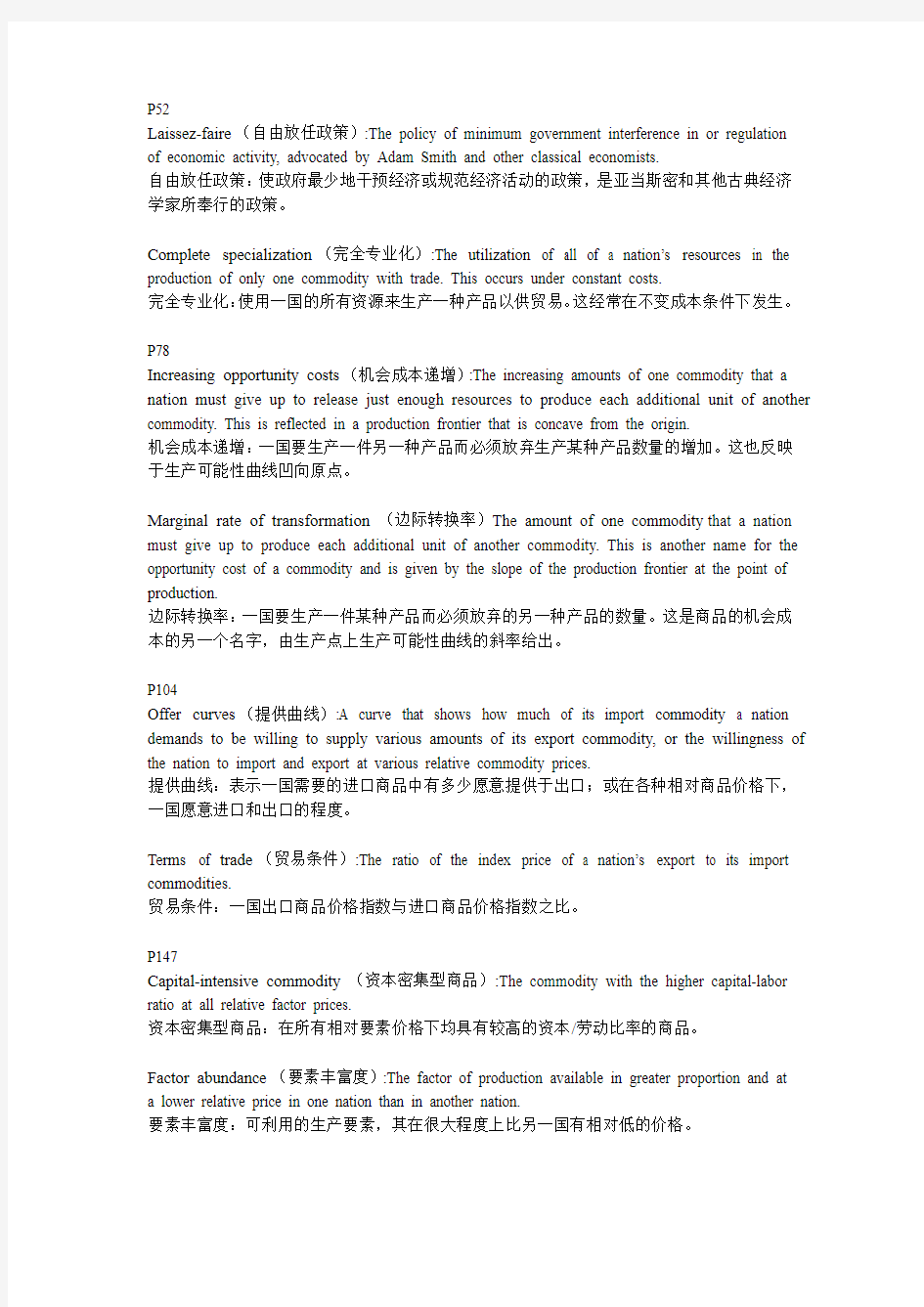
国际经济学名词解释1
- 格式:pdf
- 大小:96.18 KB
- 文档页数:3


Laissez-faire(自由放任政策):The policy of minimum government interference in or regulation of economic activity, advocated by Adam Smith and other classical economists.
自由放任政策:使政府最少地干预经济或规范经济活动的政策,是亚当斯密和其他古典经济学家所奉行的政策。
Complete specialization(完全专业化):The utilization of all of a nation’s resources in the production of only one commodity with trade. This occurs under constant costs.
完全专业化:使用一国的所有资源来生产一种产品以供贸易。这经常在不变成本条件下发生。
P78
Increasing opportunity costs(机会成本递增):The increasing amounts of one commodity that a nation must give up to release just enough resources to produce each additional unit of another commodity. This is reflected in a production frontier that is concave from the origin.
机会成本递增:一国要生产一件另一种产品而必须放弃生产某种产品数量的增加。这也反映于生产可能性曲线凹向原点。
Marginal rate of transformation(边际转换率)The amount of one commodity that a nation must give up to produce each additional unit of another commodity. This is another name for the opportunity cost of a commodity and is given by the slope of the production frontier at the point of production.
边际转换率:一国要生产一件某种产品而必须放弃的另一种产品的数量。这是商品的机会成本的另一个名字,由生产点上生产可能性曲线的斜率给出。
P104
Offer curves(提供曲线):A curve that shows how much of its import commodity a nation demands to be willing to supply various amounts of its export commodity, or the willingness of the nation to import and export at various relative commodity prices.
提供曲线:表示一国需要的进口商品中有多少愿意提供于出口;或在各种相对商品价格下,一国愿意进口和出口的程度。
Terms of trade(贸易条件):The ratio of the index price of a nation’s export to its import commodities.
贸易条件:一国出口商品价格指数与进口商品价格指数之比。
P147
Capital-intensive commodity(资本密集型商品):The commodity with the higher capital-labor ratio at all relative factor prices.
资本密集型商品:在所有相对要素价格下均具有较高的资本/劳动比率的商品。
Factor abundance(要素丰富度):The factor of production available in greater proportion and at a lower relative price in one nation than in another nation.
要素丰富度:可利用的生产要素,其在很大程度上比另一国有相对低的价格。
Intra-industry trade(产业内贸易):International trade in the differentiated products of the same industry or broad product group.
产业内贸易:同一行业或国外产品集团的不同商品间的国际贸易。
P224
Rybcznski theorem(雷布钦斯基原理):Postulates that at constant commodity prices, an increase in the endowment of one factor will increase by a greater proportion the output of the commodity intensive in that factor and will reduce the output of the other commodity.
雷布钦斯基原理:指出商品价格不变条件下,某要素赋予的增加将导致该要素密集度高的产品的产出增加并减少其他产品的产出。
Immiserizing growth(不幸的增长):The situation where a nation’s terms of trade deteriorate so much as a result of growth that the nation is worse off after growth than before, even if growth without trade tends to improve the nation’s welfare.
不幸的增长:由于增长使一国增长后比以前更贫困而导致的贸易条件恶化,甚至如果没有贸易的增长更可以增加国家财富。
P258
Optimum tariff(最佳关税):The rate of tariff that maximizes the benefit resulting from improvement in the nation’s terms of trade against the negative effect resulting from reduction in the volume of trade.
最佳关税:使一国贸易条件改善带来的收益减少贸易量减少带来的负面影响所得的净效应最大化的关税税率。
P309
Dumping(倾销):The export of a commodity at below cost or at a lower price than sold domestically.
倾销:以低于国内商品价格或低于成本的价格出口某产品。
P344
Customs union(关税同盟):Removes all barriers on trade among members and harmonizes trade policies toward the rest of the world. The best example is the European Union (EU).
关税同盟:在成员国内消除所有贸易壁垒,协调同世界其他国家的贸易政策。最好的例子就是欧盟。
Trade creation(贸易创造):Occurs when some domestic production in a member of the customs union is replaced by lower-cost imports from another member nation. This increases welfare.
贸易创造:当关税同盟成员国的国内产品由另一成员国低成本的进口品所替代时,就称为贸易创造,这增加了财富。
Trade diversion(贸易转移):Occurs when lower-cost imports from outside the union are replaced by higher-cost imports from another union member. By itself, this reduces welfare.
贸易转移:关税同盟成员国之外的低成本进口品被同盟成员国的高成本的进口品替代时,就